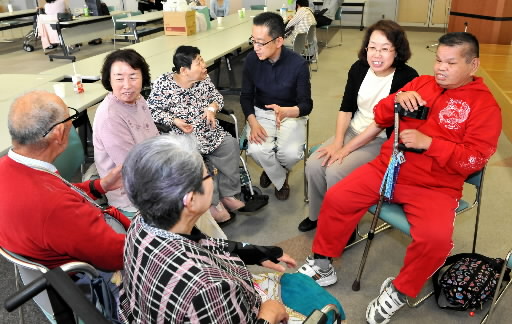Support for microcephaly patients: Regional disparities must be eliminated
Jun. 5, 2012
Enhanced government system needed
by Sakiko Masuda, Staff Writer
What sort of support should be provided to those who are disabled as a result of being born with microcephaly caused by the effects of radiation from the atomic bombing? For more than one year, a full-time counselor assigned by the City of Hiroshima has been providing meticulous support to 10 A-bomb microcephaly patients.
But the support that the 12 patients residing outside the city receive is less than adequate. The patients’ parents, who had been caring for them, are dying, and the patients themselves are now 66 years old. In order to eliminate regional disparities, enhancement of the government support system is urgently needed.
In July 2010 the Mushroom Club, a group of microcephaly patients, their families and supporters, asked the city and Hiroshima Prefecture to lobby the central government for the assignment of a counselor to provide support for the A-bomb microcephaly patients. As a result, with a subsidy from the central government, in April of 2011 the City of Hiroshima assigned a medical social worker to serve as a counselor.
Yurie Kawamiya, 56, meets with all 10 of the patients residing in the city at least twice a year. But she may meet with patients as often as several times a week to advise them on issues such as moving or the adult guardianship system, which protects their rights and property.
She also gets phone calls from patients nearly every day and accompanies those who are mentally disabled on doctor’s office visits. In this way she has gradually earned the patients’ trust. Taketsugu Chawada, 66, a patient who lives in the city’s Nishi Ward, is grateful for the assistance. “It’s a big help,” he said.
Doubts and discontent as well
About once a year representatives of the prefectural government meet with the three patients who live in Hiroshima Prefecture but outside the City of Hiroshima. The Mushroom Club also provided individual consultations at its annual meeting, which was held in the city on May 26.
Nevertheless Kimie Kishi, 66, a resident of Miyoshi in northern Hiroshima Prefecture, expressed doubt saying, “It’s the same microcephaly, so I don’t understand why there’s a difference in the support.”
Hiroshima resident Yoshio Nagaoka, 63, is president of the Mushroom Club. His 66-year-old brother suffers from microcephaly. “There are disparities in support between regions, and necessary services are not being provided where they are needed,” he said.
At the club’s annual meeting a report on a 66-year-old patient who lives in Osaka was presented. In January the woman called Sugako Murakami, a professor at Hyogo University, seeking advice. Prof. Murakami conducts research on medical social work and also provides support to the Mushroom Club. The professor contacted the Ministry of Health, Labor and Welfare and asked that a prefectural employee meet with the patient. She was told, however, that the prefectural worker in charge had been meeting with the patient and that the patient should call the prefecture government herself.
There are other problems as well. The Health, Labor and Welfare Ministry prepared a list of the persons in charge in each governmental jurisdiction where microcephaly patients reside and created a network by which they could share information. But, according to the City of Hiroshima, there have been no requests for advice or information from any jurisdictions other than Hiroshima and Yamaguchi prefectures and the City of Nagasaki.
In Kanagawa Prefecture and other areas where there is only one microcephaly patient, information about where they can seek advice is provided in writing only. Last summer, the person in charge in Osaka Prefecture, where two A-bomb microcephaly patients live, met with the patients and their families, but they reportedly felt uneasy because they didn’t know what sort of attitude the person would take when asked for advice.
Request for training of people in charge
“Instead of waiting for patients to contact them, I would like the authorities to approach the patients and try to help them resolve their problems,” said Mr. Nagaoka. “The central government shouldn’t leave everything up to local jurisdictions but should make a real effort such as by asking local governments to meet with patients.”
Prof. Murakami said, “The central government should exercise its leadership to see that patients can get the same level of care anywhere in the country.”
In an effort to enhance support, at its annual meeting the Mushroom Club affirmed its intention to ask the central government to conduct a seminar for all of those in charge of assisting microcephaly patients. With a view to bolstering its request, the Mushroom Club also plans to seek the cooperation of the two chapters of the Confederation of A- and H-Bomb Sufferers Organizations (Hidankyo) in Hiroshima Prefecture.
Keywords
A-bomb microcephaly
Some unborn babies that were exposed to a heavy dose of radiation early in the pregnancy were born with microcephaly, which may be accompanied by mental and physical handicaps. According to the Ministry of Health, Labor and Welfare, as of the end of March 2011 there were 22 A-bomb microcephaly patients in Japan. Thirteen of them reside in Hiroshima Prefecture with 10 of those in the City of Hiroshima. Of the others, three live in Nagasaki Prefecture, including two in the City of Nagasaki. There are two patients in Osaka and one each in Tokyo, Yamaguchi, Kanagawa, and Fukuoka prefectures.
(Originally published on June 4, 2012)








